
I was given a membership to the Pacific Railroad Society after beings the guest speaker at their Winter Banquet in December. Jim Nowell, a good friend, fellow Orange County Railroad Historical Society Member and PRS member, decided that he should show me what Society owns. We picked April 8th for the visit and soon enough, that morning finally arrived.

I drove to Santa Ana and before my Pacific Surfliner arrived, checked the construction on our new east platforms. Those new shelters will keep the sun off while waiting for a train, but when it rains and the wind blows, they will be useless.

The new bridge and east platforms at the south end of the station.
Pacific Surfliner 565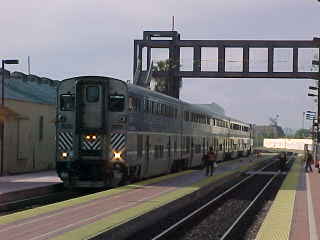
This train arrived on time and we proceeded north towards Fullerton. At Fullerton Junction, we sat and waited as first Pacific Surfliner 566 went by, then an westbound eleven-engine BNSF stack train with one lone Canadian National locomotive in the mix. Jim was waiting on the platform and soon we were driving north on California Highway 57 to Arrow Highway, which when you go straight at the exit, will take you onto Bonita Street. After crossing the former Santa Fe Second District, the San Dimas station is on your right. We parked in the lot and looked around, as the museum did not open until 10:00 AM.

Santa Fe San Dimas station built in 1934. The completion of the Santa Fe Railroad line in 1887 from Los Angeles to San Bernardino marked the birth of San Dimas as a major citrus farming community. The San Jose Ranch Company, formed by Moses Wicks and four partners, laid out town sites after the company acquired most of the land that would later become San Dimas.
Multiple tracks running past the depot serviced heavy freight trains, citrus trains and passenger trains. The original depot opened in 1889, but was destroyed by fire in 1933. It was replaced with the current Art Deco style building in 1934 and operated until 1961.
In the 1990’s, the City of San Dimas was using the depot as a senior center, then built a new senior center closer to City Hall and the depot fell into disrepair. Because the depot was an excellent example of the Art Deco style that influenced the railroad stations of the time, Pacific Railroad Society decided to lease it in order to preserve the building and its history.

The view from the southwest showing the depot and the former Santa Fe Second District tracks. Trains such as the Super Chief, El Capitan and California Limited passed the depot during the Santa Fe years. During Amtrak, it was first the Super Chief, then the Southwest Limited, before it became the Southwest Chief. Add in the Desert Wind, and along with the Southwest Chief, were the Amtrak trains I rode passed by depot. Today, other than the Metrolink Rose Parade train, there are no regular passenger trains that travel by this once-proud station.


The station from two different angles.

On display was a piece of rail made in Joliet, Illinois in 1887.

The Train Shop, an excellent all-gauge modal railroad shop, is located across the street from the depot and the two of us visited this unique store before the museum opened.
Pacific Railroad Society History, Museum and LibraryThe Pacific Railroad Society is one of the oldest railroad enthusiast organizations in the country. It was formed in 1936, when six railfans in the Los Angeles area banded together as the "Railroad Boosters". In 1949, a new name was adopted: Pacific Railroad Society. It became a non-profit in 1957, and changed to a charitable public-benefit organization in 1980 to facilitate raising funds and soliciting tax-deductible donations to establish a library and museum.
Excursions were an important part of PRS from its beginning and included visits to such now-legendary places as Pacific Electric's Torrance Shops, the Mount Lowe Railway and San Luis Obispo's narrow-gauge Pacific Coast Railway. All PRS activities are carried out on a volunteer basis. There are no paid staff and no director salaries or stipends. Operating funds are raised through membership dues, donations, rail excursions and gift shop sales.
The goal is to restore the depot to represent a working railroad station. Artifacts and exhibits on various aspects of railroading are on display there. The depot also houses our extensive railroad research library containing books, documents, maps and photographs collected since the 1930's. This facility is open to the public and staffed by PRS volunteers.
Our VisitWe were given a complete tour and left with a better knowledge of what the PRS does. We drove back down California Highway 57 to Interstate 10, with its ridiculous traffic, to the Interstate 710 to East Los Angeles, exiting at Olympic Boulevard and made our way to the PRS Yard.
A Pacific Railroad Society Yard TourWe arrived at the yard and walked inside the gate, where I was introduced and Will Walters offered to give a quick tour.

In 1955 and 1956, the Union Pacific Railroad and the Wabash Railroad, both of whom partnered to run the City of St. Louis, received some of the last sleepers to be built before the advent of Amtrak. In addition, these cars, named in the National series, were also the last passenger cars built with open sections.
The National cars contained 6 sections, 4 double bedrooms and 6 roomettes (6-4-6). Although similar in accommodations to the pre-war American (4-6-6) series of cars built for the UP, the Nationals had numerous improvements and modifications. The most notable changes from the Americans design were the placement and design of the four double bedrooms. In the Americans, the double bedrooms were over one of the trucks and closest to the vestibule. This meant that one of the most expensive accommodations were located in the one of the noisiest areas of a passenger car. In the Nationals, the bedrooms were moved to the quieter center of the car, away from the trucks and vestibule. In addition, unlike the American bedrooms, the toilets in the National bedrooms were enclosed.
The Nationals were assigned to the City of Portland, City of Denver, and City of St. Louis trains. Numerous changes in the passenger traffic occurred on the UP during the late 1950's and early 1960's. By June 30th, 1968, due to reduction in passenger traffic on the UP and the discontinuance of the City of St. Louis with the merger of the Wabash into the Norfolk and Western, the Nationals' service was relegated to the secondary service on the Denver to Portland Portland Rose. By December 1969, the Portland Rose was history and the Nationals were idle. During the 1970-71 ski seasons, the UP Los Angeles passenger office operated at least two ski trains to Sun Valley utilizing the idle Nationals. In addition, the Union Pacific used the Nationals in special excursion service until the advent of Amtrak in 1971.
Thin wheels and cracked discs delayed the refurbishment of the National Embassy. It was stored and never saw operation service with the Pacific Railroad Society. In 1977, the National Embassy was traded to William Gawzner of Santa Barbara for a former Amtrak, former Southern Pacific Daylight coach.

Pacific Railroad Society 45 ton switcher 7199, ex. United States Army 262098, nee United States Army 7199, built by General Electric in 1941. It was rebuilt at Hill Air Force Base in Ogden, Utah in 1953 and donated by the United States Marine Corps in 1988. National Forum.
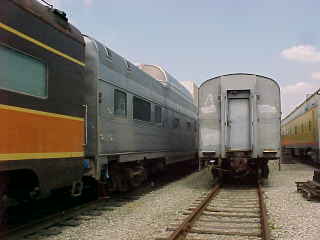

Great Northern 46-seat seat Great Dome 1330, ex. Gold Coast Railway Museum 1995, exx. Amtrak 9470 1972, exx. Burlington Northern 4610 (number not applied), nee Great Northern 1330 built by Budd Company in 1955.
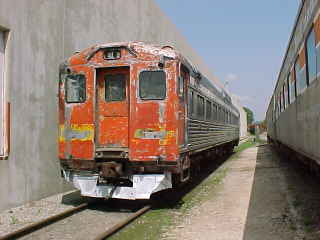


Santa Fe RDC-1 DC-191 built by Budd Company in 1952. The railroad its last new self-propelled railcars in April 1952 in the form of a pair of stainless steel Rail Diesel Cars, numbered DC-191 and DC-192. Each car had a seating capacity of 88 passengers. Budd designed the RDC-1 with a control cab at each end, but Santa Fe intended to operate their cars as a set and only maintain one control cab per car. As a result, only end of each car was decorated with a simple but attractive silver paint scheme with a square red, yellow, and black Santa Fe emblem on the end door and "cat whiskers" on either side.
The pair of RDC's began their careers running between Los Angeles and San Diego, making two round trips per day as trains 80, 81, 82 and 83. Within a year, the stepwells were removed from the control cab end of each car. A solid cab floor was installed and stirrup steps were added for crew access to the side door. Passengers boarded the cars via the remaining stepwells at the other end of each car, which were situated in the center of the set when both cars were coupled. The steel plate on the cab ends of each car were also reinforced to provide better collision protection for the crew during grade crossing accidents. Such accidents became frequent enough on the Surf Line that Santa Fe endeavored to make the cars more visible to motorists.
In mid-1955, the railroad repainted the cab ends of the cars red with a noseband similar to the standard Santa Fe "Warbonnet" passenger scheme, but without the actual Warbonnet curve on the sides of the cars. A Pyle National Gyralight oscillating headlight was also installed on the end door of each car above the noseband. The lights included a white light for normal use and a red light that came on during emergency brake applications.
On the evening of January 22, 1956, less than a year after receiving their new eye-catching paint, the pair of RDC's were operating as Train 82 out of Los Angeles with a capacity load. Approaching Redondo Junction, the cars entered a 15 mph speed restricted curve at nearly 70 mph, turned over on their sides, and slid for several hundred feet. Thirty passengers were killed and another 140 injured in one of the state's worst passenger rail accidents. Santa Fe had been planning to replace the RDC's with a conventional streamliner to handle growing passenger loads on the run to San Diego, and the accident hastened their replacement. It would be the last time the cars would lose an assignment due to increasing ridership.
The damaged cars were sent to the Topeka shops on flatcars in mid-1956 to be repaired. The DC-191 emerged from rebuilding in mid-1957 looking much as it had before the accident. As for DC-192, the shops added a baggage section at the expense of more than half its seats - the "new" DC-192 could only accomodate 36 passengers. The RDC's next assignment was to trains 311 and 312 between Newton and Dodge City, Kansas via Great Bend. Ordinarily, DC-192 ran solo on weekdays, with DC-191 joining it on weekends. This assignment lasted until the train was cancelled in June 1965. The cars were then tranferred to the El Pasoan schedule, Train 13 and 14 between Albuquerque, New Mexico and El Paso, Texas. It would turn out to be their final assignment for the Santa Fe. When the schedule was eliminated in April 1968, the cars were stored.
In February 1970, DC-191 was sold to the Baltimore & Ohio for service with other RDC's in Pittsburgh-Versailles, Pennsylvania commuter service. B&O initially numbered the car 1913, but soon renumbered it to 9918. When the Port Authority of Allegheny County (PATrain) took over the service in 1975, they leased the 9918 and other RDC's from B&O. The former DC-191 was involved in another spectacular wreck on December 30, 1976 when a four-car set of RDC's was set loose by vandals at Glenwood Yard in Pittsburgh. The cars ran unattended for over sven miles until they struck a standing Pittsburgh and Lake Erie freight at Demmler Yard. The two lead cars were destroyed, but fortunately the 9918 was on the far end of the set and escaped relatively undamaged. The car was quickly returned to service following the accident.
PATrain returned the leased RDC's to B&O in 1980. B&O then sold the 9918 to the Maryland Department of Transportation in 1981 for commuter service with other RDC's between Brunswick, Maryland and Washington, D.C. Maryland's commuter rail operations were renamed MARC (Maryland Area Rail Commuter) in 1984, and the former DC-191 was renumbered 18. The car served until 1993, when it was retired and used as a parts source to keep other MARC RDC's running. In 1995, MARC 18 was purchased by Kasten Rail Car Services (later Illinois Transit Assembly Corp.) and moved to East St. Louis, Illinois for storage. In 2004, ITAC swapped the RDC to the Pacific Railroad Society for former Illinois Central sleeper "Bloomington". The car was moved west to Commerce, California for storage and restoration to its former Santa Fe identity at PRS' Saunders Yard.

Gulf, Mobile & Ohio 8 section-4 roomette-3 bedroom-1 drawing room "Timothy B. Blackstone" built by American Car and Foundry in 1950. Retired in 1969, it was sold to the Pacific Railroad Society as PAR 2 and renamed "Golden Sunset", and was later renamed back to "Timothy B. Blackstone" and assigned PPCX 800367.
By late 1947, the sleeper cars were still just a drawing. In addition to a shortage of materials, the inability of the Gulf, Mobile, and Ohio Railroad to make decisions on a variety of design options delayed the delivery of the sleeping cars until 1950. Originally, the four sleeping cars were supposed to be 22 or 24 roomette cars. In June 1947, the floor plan was changed to an 8-4-3-1 from the roomette configuration. This change would allow better utilization of the cars by allowing an overnight trip to St. Louis from Chicago and back on the Midnight Special after a trip from Mobile to Chicago had been completed via the Gulf Coast Rebel/Abraham Lincoln trains.

Pacific Railroad Society 4-4-2 sleeper "Imperial Bird", nee Union Pacific "The Imperial Bird" built by Pullman in 1942. It was sold to the PRS in 1969 and used during the 1970's in excursion and charter service on several routes throughout the United States, Canada and Mexico.

Pacific Railroad Society dormitory club car "Cajon Pass", nee Union Pacific 6101 built by American Car and Foundry in 1949. In 1968, it was reassigned to the City of Kansas City (actually the City of St. Louis with a name change due to dropping the Kansas City to St. Louis segment) then retired in 1969 and sold to PRS in 1970. In addition to the lounge section which seats 38, this car has a snack bar and three dormitory rooms which sleep a total of 14.

Passenger car of unknown history.
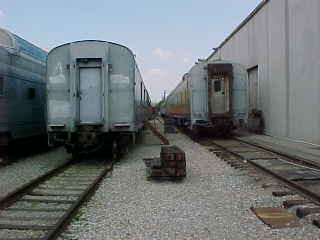
Yard view.

Pacific Railroad Society caboose 25052 1959, nee Union Pacific 3752 built by Mount Vernon Car Company in 1942. It was one of the first with steel exterior. After retirement in 1973, it was sold to a private individual in Los Angeles and stored on a siding about three miles from San Dimas then leased to Pacific Railroad Society in December 1991, later donated and moved to the society's location in San Dimas.

Pacific Railroad Society caboose 25886, nee Union Pacific caboose 25886 built by International Car Company in 1979.

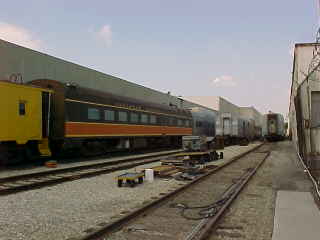
Illinois Central dining car 4110 "Shadrach Bond" built by Pullman Standard in 1949, after which we thanked everyone, including Will, for the great tour.
The plan was for Jim to drive me back to Fullerton to catch Pacific Surfliner 774 but traffic came into play on Interstate 5 which made that impossible, but taking me to Santa Ana would easily buy us ten minutes.
Pacific Surfliner 774Jim dropped me off with plenty of time to spare and I waited for Pacific Surfliner 774 to take me south to San Diego, relaxing in the lower level of the cab car until our six-minute early arrival there. I detrained for some pictures then would sit in the sun in the patio area.

Pacific Surfliner 774 after arriving in San Diego.

The private car "Pacific Sands" was laying over for the weekend.



Santa Fe is alive and well at the San Diego station.
Pacific Surfliner 785I boarded this train and we departed on time. However, when we tried to leave Old Town, a weekend stop, the locomotive would not work. A San Diego mechanic came up to Old Town on Coaster 647 to assist with the problem, which was a new cable from the cab car back to the engine, so he was able to fix it on the spot. Pacific Surfliner 578 came flying through before we departed and proceeded north 42 minutes late. At Solana Beach, we arrived just as Pacific Surfliner 580 was leaving. We then met Pacific Surfliner 582 at CP Songs and passed Pacific Surfliner 784 on double track just south of Irvine.

Pacific Surfliner 785 returned me to Santa Ana thirty-six minutes late. I drove home a happy man after finally having the opportunity to see the San Dimas station with the PRS Museum and Library, the PRS passenger car collection in East Los Angles and as always, my great rides on Amtrak.
| RETURN TO THE MAIN PAGE |